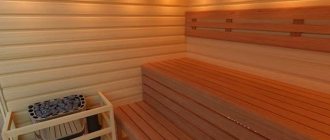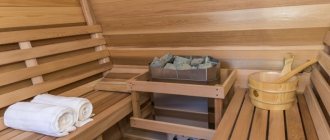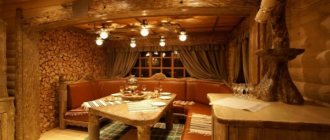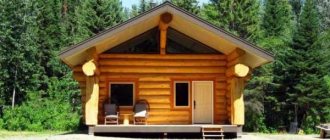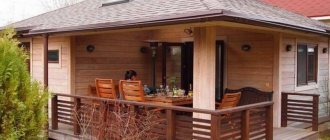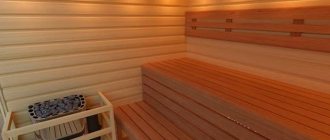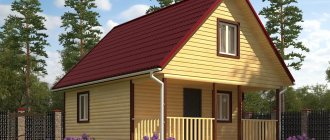The advantages of a bathhouse are difficult to overestimate. This is a great place for rest and relaxation. Bath procedures improve sleep, normalize blood pressure, and remove toxins. Neither Jacuzzis, nor showers, nor other delights of plumbing can compare with the advantages and such widespread popularity of the bathhouse. Today we’ll talk about the features of its internal contents in terms of decoration and design in general.
Types of interior design of baths
The classic layout of a bathhouse includes 3 rooms: a dressing room (dressing room), a washing room (shower room) and a steam room. Although in traditional Russian baths the steam room and shower can be combined. All additional premises - a font (swimming pool), a games room (billiards), a kitchen, a recreation area, a toilet, a smoking room - are a matter of financial capabilities and personal preferences of the owners.
However, the most popular decoration is in the usual Russian style - restrained, laconic, with a massive table, benches and couches. Billiards or TV will add a touch of modernity.
The interior of an old-style bathhouse can be complemented with forged elements, wooden household items and utensils decorated with carvings. Walls decorated with oak, birch brooms or bundles of fragrant herbs will also look colorful.
Styles and photos of the best solutions
The design of the bath should not be bright and pretentious; the emphasis is on a calm and even peaceful atmosphere. First of all, to create comfort, the psychological aspect is taken into account: the steam room room, and the bathhouse in general, does not have a large area, so it can have an emotionally overwhelming effect. To prevent this from happening, the design of the premises should be as simple and neutral as possible.
Steam room with natural light Source vsaunu777.ru
See also: Catalog of bathhouse projects presented at the “Low-Rise Country” exhibition.
A little brightness can be added to the interior of a modern bathhouse with the help of well-organized lighting and functional decor:
- Hours.
- Thermometer on the wall.
- Pictures.
- Mirrors.
- Venikov.
- Buckets and scoops.
- Textiles.
The design of a sauna and bathhouse differs from the design of residential premises. It doesn’t matter what design style is chosen, the main thing is to ensure functionality and safety. Excessive decor and furnishings are of no use here.
Room for relaxing with guests Source fodors.com
Here are some design options:
- Traditional Russian style involves the use of natural wood finishes. The steam room is equipped with a stove, and in the dressing room they use carved decor and colorful rugs on the floor. In the rest room, the table will be decorated with a tablecloth and a samovar, wicker baskets and boxes. The furniture is very simple - a table and benches with embroidered rugs. It is important that the color of wooden furniture, walls and floors do not match.
Bathhouse design in Russian style Source pinterest.com
Beautiful relaxation room Source banyabest.ru
- The chalet style is more restrained. If country and Russian style allow for carved decor, here the emphasis is on the feminine or masculine energy of the interior. In the first case, edged weapons on the walls, guns, trophies, and forged decor are used as decor for the rest room, as if hinting that this bathhouse belongs to a hunter. If the hostess is a woman, then the interior is decorated with paintings depicting landscapes, a ceramic tea set, embroidered tablecloths and napkins, wreaths of fragrant herbs and bouquets of dried flowers.
- A bathhouse in a modern style looks simple and elegant. Wood for its finishing should have a smooth surface without emphasis on natural patterns. The equipment is modern. You can install a multifunctional cubicle in the shower. Decorative emphasis is placed on lighting and backlighting. Minimum decor and maximum functionality is the motto of the modern design style.
Decorating an antique Russian bathhouse Source happymodern.ru
See also: Catalog of companies that specialize in the design and construction of bathhouses.
We offer a photo gallery of original solutions for a bath.
Modern steam room Source remontbp.com
Steam room decorated in high-tech style Source falschewimpern.org
Stone for wall cladding Source pinterest.es
Shelf lighting Source pinterest.com
Modern solution for a bath Source mysamostroy.ru
Special lamps for baths Source indianplywoodcompany.com
Marble wall Source topdizz.com
Bright warm lighting in yellow tones Source ro.aviarydecor.com
Wood panels Source realestateonesuccess.com
Materials for finishing the bath inside
Materials for the interior decoration of a bathhouse must meet a number of conditions:
- resistance to temperature changes, high temperatures, high humidity;
- safety – the materials used must be hypoallergenic, not cause burns upon contact with skin and not release toxins in hot weather;
- strength and durability;
- hygiene - the finishing material should be optimal in care - easy to wash, and not react with household chemicals;
- aesthetics – beautiful interior design that does not irritate the eye – is what you should strive for when decorating the interior of a bathhouse. In this case (especially for Russian baths), wood is ideal. This material meets all the above requirements, is completely environmentally friendly, and, moreover, has an aromatherapy effect. The main thing here is to choose the right type of wood individually for each type of room.
How it all began
Initially, at the dawn of civilization, no one thought about design, and no one even knew the word. Human life was fleeting, and functionality was put at the forefront, while beauty and nobility remained unclaimed. The first Russian baths were heated using black heat, so whether the interior was decorated or not did not matter.
After the first two months of using the bathhouse for its intended purpose, the walls, ceiling and shelves of the room acquired a deep black color, which would certainly be the envy of modern manufacturers of paint and varnish products. The situation changed radically after the invention of the chimney. The bathhouse turned white, and for the first time users thought that beauty rules the world.
The most powerful word in the design of baths, as such, in the realities of the ancient world was said by the Romans, with their immortal public baths - thermal baths and an ineradicable craving for beauty. Monumental columns, an abundance of marble and sculptural compositions to this day set a largely unattainable standard for the design of a bath space. In modern realities, these traditions are to some extent supported in the East.
Turkish hammam baths are still distinguished by a reverent attitude to the design of the interior decoration. Well, what can we take from the Turks, if among the men there, the highest manifestation of fashion and style is considered to be the presence of pointed patent leather boots, always bright red. With us everything is a little simpler. Including in the bathhouse world.
Steam room
For the interior decoration of the steam room, only deciduous wood is suitable. This type of wood does not heat up, does not emit resins, and, importantly, even with light ventilation it dries very quickly, preventing dangerous fungus from developing. We list the most common types:
- linden – visually attracts attention, does not darken over time, has low density and heat capacity: it heats up quickly, but it is impossible to get burned on contact. When heated, it releases a pleasant delicate aroma. Linden finishing is quite popular, so it is quite affordable.
- aspen is a common material for northern regions. The wood is durable, difficult to split or split, and has bactericidal properties;
- alder – has a beautiful appearance, is pleasant to the touch, resistant to cold and hot water, condensation and steam, alkaline and acidic detergents, and is easy to process.
- Abash is a tree from the tropics of Africa. Even in the hottest heat, it hardly heats up and maintains a temperature close to the human body temperature. Even under the influence of external factors (water, temperatures and steam) it does not darken at all.
Important! Wood cannot be coated with varnish or paint, even of the best quality. When heated, they release an unpleasant chemical odor. During the installation process, nails (screws) must be covered at the top and set deeply, otherwise they may burn when heated. It is better to mount the lining vertically, as drops formed by condensation will drain faster. The junction of the floor and walls must be protected with high skirting boards made of a waterproof material.
Typically, the steam room has wooden floors made of hardwood. But still, tile will be preferable. It washes well, dries quickly and is resistant to fungus. If this coating seems cold to you, you can put a removable wooden grate on top.
The furniture in the steam room is predominantly round in shape and made of aspen, alder or linden wood.
Floor construction
Naturally, it must be made of wood. The board is tongue-and-groove or precisely adjusted during normal cutting of the sidewalls. But only for a well-cleaned base with a good concrete screed.
The boards are placed with a slight slope to drain moisture, and so that the floor of the steam room is approximately fifteen centimeters higher than in the bathhouse.
News site- Features of electrical wiring installation in houses made of SIP panels
- How to choose a cast iron bath
The logs are installed at intervals of one meter, but only under boards of thickness that do not bend under a person at this distance. Fasten the boards with anti-corrosion screws.
Waiting room
The room is not hot, but retains heat. Therefore, coniferous species will be an excellent material for finishing here. Their noble aroma is not only pleasant, but also incredibly useful. Phytoncides have a beneficial effect on the immune system, stimulate the body's resistance to various infections and improve overall well-being. Let's look at the main types:
- Pine is a very popular material for dressing a dressing room, because it has a number of advantages: economical, durable, environmentally friendly and quite durable. May change color slightly over time, acquiring a reddish tint. Scandinavian pine with smooth pinkish wood is becoming increasingly popular. Its annual rings have an original decorative pattern;
- spruce – has a uniform structure, does not crack when drying, and is slightly lighter in color than pine wood;
- fir - the main characteristics are almost the same as spruce, while almost no resin is released from its wood.
Birch is a good option for a deciduous tree for a dressing room. In any case, when decorating, the main thing is to follow the basic rule - the entire room should be paneled with the same type of wood.
From the history
Initially, the wooden building was primitive and it was heated “black”. The stove did not have a chimney, so the inside of the wall was covered with a dense layer of soot. The interior of the bathhouse of those times left much to be desired, there was no talk of any aesthetics, only functionality mattered. It was not very convenient to steam in such a room, but at that time there was no alternative. Over time, the buildings became more and more monumental. Stoves began to be equipped with chimneys, and the ritual of ablution became more and more complex and overgrown with traditions. For example, in each bathhouse, according to legend, there lived a special “brownie”: an always dirty lover of doing dirty tricks on those who did not butter him with a gift in time.
Despite the main purpose of the building - cleansing the body, people associated it with dirt. Icons were never hung here and fortune telling was carried out, which were considered unclean. The bathhouse was placed on the outskirts, as far as possible from the house: in vegetable gardens and “hollow places.” Fire safety requirements? Not at all, as a dirty building, the bathhouse should not have been in contact with the house. Utensils made from it were never brought into living quarters.
Steam rooms also became popular in Ancient Rome, whose citizens carefully monitored their appearance. On the ruins of a once great empire, the remains of these complexes have been preserved, which speak of the high culture of their creators. In Rome, baths were used not only for washing, but also for holding debates and lively conversations on political and philosophical topics. Now the baths have a modern look, and they work on their design no less than on the interior of the house. The building will become a real decoration of the summer cottage. A country house cannot do without this addition, pleasant in every sense. A bathhouse is usually built behind a yard near a recreation area: a gazebo, a summer kitchen, a barbecue and a garden. Unfortunately, combining this building with other structures into a single complex is prohibited by regulations that regulate the minimum distance between buildings on private property. A typical bathhouse is supposed to have three rooms:
- Steam rooms;
- Rest rooms or dressing rooms;
- Wash room.
In various designs, the number of rooms can be reduced or supplemented. For example, if there is direct access to a pond or swimming pool, then there is no need for a shower (washing) room. In summer you can take a dip in the cool water, and in winter you can organize a plunge pool in the ice. Some luxury options may have entire pool complexes inside. In this way, owners provide an alternative to hot “bathing.” On a site, a bathhouse can not only be a separate building, in some cases (small site), the owners, in order to save space, arrange a sauna in their basement, attic or on the ground floor. Before starting construction, the building design is prepared in advance. Since it is classified as a fire hazard, it would be useful to consult with professionals. Sometimes complex two-story structures are erected with a miniature fence, veranda, porch, toilet, billiard room and courtyard. To build such complexes, it is better to contact a professional designer-architect. He will prepare an individual project. They start building simpler structures with their own hands. So, let's try to sort out the types of baths, the features of their construction and common mistakes that novice decorators make.
Finishing a bathhouse inside: basic rules
A bathhouse is, first of all, a place to relax. It is better to exclude bright colors and expressive shapes here. The main principle is to create an ideal environment for a cozy and relaxing pastime, without unnecessary details.
Lighting should be soft, with warm shades, conducive to a pleasant and relaxing holiday. This effect can be achieved by using a two-tier lampshade that diffuses light. All electrical wiring parts must be reliably protected from moisture.A modern interior for a bathhouse is a manifestation of the designer’s imagination and taste. Tell us about your favorite places to rest and relax. Were there any of them that impressed you the most with their exquisite interior?
Restroom
This room is a living room. Only here the situation vaguely resembles an ordinary room in the house. The main task of the designer is to create a cozy and comfortable atmosphere for a good rest. There must be places for sitting and lying, with a soft surface as opposed to hard steam benches. Also, in the bath living room, a table or bar counter must be installed in addition to it. For a more comfortable stay, you can place a TV in the room or think about other ways of entertainment.
